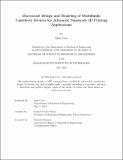Macroscale Design and Modeling of Multifluidic Cantilever Devices for Advanced Nanoscale 3D Printing Applications
Author(s)
Ceco, Irma
DownloadThesis PDF (2.759Mb)
Advisor
Youcef-Toumi, Kamal
Terms of use
Metadata
Show full item recordAbstract
A reliably functioning nanoscale 3D printer would be revolutionary in the advancement of the field of bioprinting and nanoprinting technologies; it would have many broad ranging potential applications such as the creation of biocompatible medical devices, alleviation of disease/medical complications through human organ fabrication, optimization of semiconductor manufacturing processes, and many others. One of the current focuses of this research is addressing the technical challenges associated with the development of a nanofluidic device that is capable of producing precise multifluidic, multimaterial prints. Thus, the primary objective of this thesis project is to design, model, and fabricate macroscale models of three potential fluid switching mechanisms/devices that can be implemented onto
the existing nanoscale 3D printer to accommodate the use of multiple materials in a desired print. The project will develop designs of different potential fluid switching mechanisms, model their performance and fabricate them for future experimentation, and attempt to determine a suitable scaling factor for transitioning the macroscale model to micro/nanoscale dimensions while ensuring that performance of the device remains replicable. Preliminary functional requirements of the device/mechanism include steady state fluid switching capabilities, compatibility with current AFM nanoscale 3D printer set up and printing fluids, and the ability to reliably create a seal and ensure minimal contamination between fluids while
still achieving laminar output flow for printing.
Date issued
2024-05Department
Massachusetts Institute of Technology. Department of Mechanical EngineeringPublisher
Massachusetts Institute of Technology